How to equip an eco-house: the construction of a country house according to environmental standards
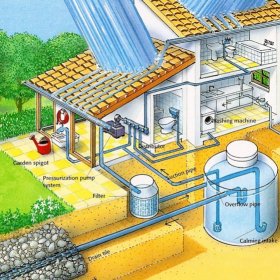
In foreign countries, in particular in the Scandinavian countries, ecological housing has become a familiar option for a private home. Eco houses are comfortable for residents and safe for the environment. Own heating system operates without the use of fuel, and organic waste is processed naturally and becomes fertilizer for the household plot. Let's consider in more detail what non-traditional technologies can be used in the house so that it becomes environmentally friendly.
Content
Features of insulation and heat supply
Typically, the heating system at home operates by burning fossil fuels: fuel oil, coal, gas and even firewood. During the combustion process, a large amount of waste products enters the air. How to avoid this? Firstly, you should insulate the house as much as possible, and secondly, it is worth considering alternative energy sources. A heat pump or solar panels require a considerable initial investment, and the use of a cavitator is an economical option, although not familiar to most owners.
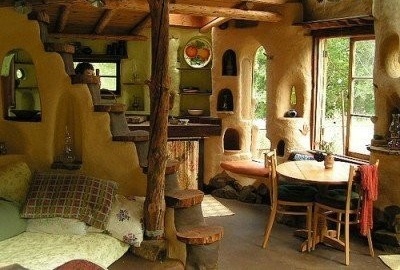
Oddly enough, houses made of clay, sand and straw have gained immense popularity. Round buildings perfectly retain heat in the southern regions, but they are not suitable for northern latitudes with severe winters
Arrangement of an eco-house during construction
Ecological materials for building a house are any natural wealth - wood, stone, brick, made, as you know, from clay, clay itself, straw blocks.
In the northern and temperate latitudes, wooden buildings are preferred - warm, “breathing”, most suitable for a changing climate. Depending on the type of soil, a pile or strip foundation is erected, a log house is installed on it, for the construction of which wood can be used in any of its manifestations: round wood, glued timber, logs.
Sheathing is done with wood-based panels, clapboard, block house. Between the walls of the log house and the sheathing, insulating mats with vapor protection are laid. The optimal material for windows is a three-layer glued beam, which has thermal conductivity of wood, but is more durable. The foundation is decorated with stone or ceramics, which not only serve as an element of decoration, but also protect the lower part of the building from moisture and wind. Thus, the house was environmentally friendly. How can a heating system be equipped so that it does not contradict the general trend?
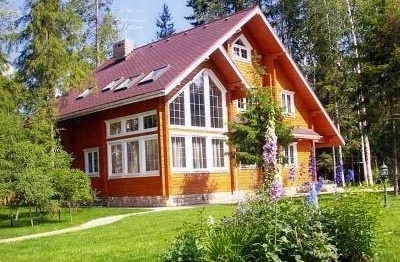
Softwood veneer, which is the basis of glued beams, gives the structure extraordinary strength and wear resistance. In addition, timber houses do not need additional finishing work, as they look quite presentable
Hydrodynamic fuelless heat generator
The operation of the heat generator with a cavitator is ensured by connecting to an electric source, without which the pump motor cannot function. The principle of cavitation is based on the fact that the liquid, circulating in a closed circuit, is gradually heated, that is, it does not require additional heating by the boiler, due to which scale is usually formed. Modern equipment is equipped with a cavitator installed in the circuit. It does not play a role in heating the liquid, but the main conversion of kinetic energy into thermal energy occurs in it, in addition, it serves to protect the pump from premature wear.
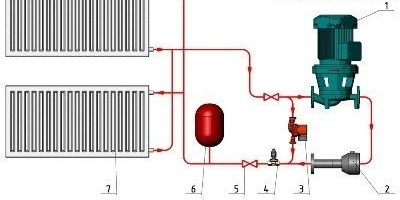
The structure of the heat generator includes: 1 - the main pump; 2 - cavitator; 3 - circulation pump; 4 - electric / magnetic valve; 5 - valve; 6 - an expansion tank; 7 - a radiator.
The efficiency of a fuel-free heat generator can be improved by using an additional storage and underfloor heating system. To ensure a sufficient amount of hot water, an indirect heating boiler is connected. Spare, and in the summer season and the main source of heating can be the solar collector. Thanks to the solar systems, the heat generator is completely switched off in the summer.
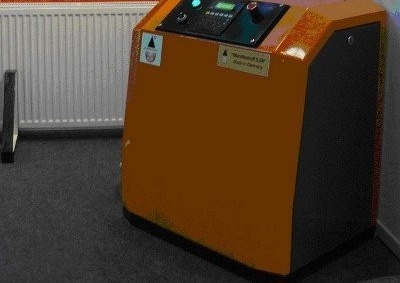
To connect the heat generator, just connect it to the power cable and two pipes of the heating system: input and output. As you can see, it takes up a little space
The use of cavitation in water supply
Cavitation is very useful if the eco-house is far from civilization, and water from nearby sources needs to be disinfected. For starters, we will consider traditional methods of water purification, and make sure that the hydrodynamic technology has undeniable advantages.
Traditional water disinfection technologies
Some of these methods are used everywhere, others are used occasionally, but they are known to everyone who studied physics and chemistry courses at school:
- chlorination;
- ultraviolet radiation;
- ozonation;
- iodization;
- ultrasonic disinfection.
The most popular method of chlorination is as beneficial as it is harmful. Not only does chlorine destroy far from all bacteria, it is involved in the synthesis of new substances that are toxic and dangerous to health. Of course, the environmental friendliness of water chlorination for home use is out of the question.
Ultraviolet radiation is useless for neutralizing water with turbidity and the presence of suspensions, so this method is only good for a clear liquid. Ozone does a great job of cleaning water, but it requires high voltage and a large amount of electricity to produce it, and the substance itself is toxic and explosive. Ultrasonic technologies are not sufficiently developed, so far they have found the main development only in medicine - for disinfection of instruments. The use of iodine, which is in demand except for cleaning pools, is also little involved.
Environmental hydrodynamic method
This technology is so effective that it allows you to purify water on an industrial scale, that is, one installation is enough for 2-3 houses (if the capacity is 500 l / h). The only condition for full disinfection is the absence of suspension. For its implementation, water intake takes place from the upper layers of the source (river or lake), and then the water is additionally filtered and sedimented in a special tank. After cleaning, even household wastewater that has passed through a deep-septic tank becomes drinkable.
The principle of operation of the cavitation installation is simple.Water passes through the filter, then the heat exchanger and enters the hydrodynamic system, where it is processed by cavitation. Then it returns to the heat exchanger for cooling, from it to the cooling condenser and reaches the finishing stage - additional filtration. You can use multiple filters with carbon or charcoal-silver cartridges. With the help of cavitation, water purity indicators reach 100%, and electricity consumption is reduced by 40-50%.
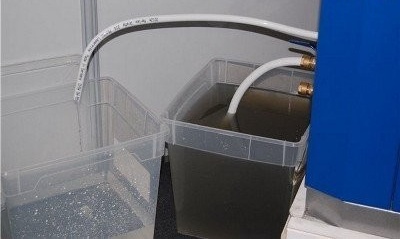
This illustration confirms the excellent operation of the water disinfection plant. In one of the containers is dirty sewage water, in the other - already cleared by cavitation
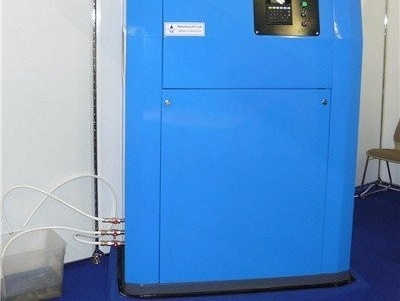
For the uninterrupted functioning of the water disinfection unit, a voltage of 380 V is required, a power consumption of 7.5 kW, an electric power frequency of 50 Hz
Household waste
The issue of recycling is most acute, since it is household waste that pollutes large areas of land. Some materials decompose over decades, others emit substances hazardous to nature, as a result, the animal and plant worlds suffer, and with them the person himself. It turns out that in a private house there is an opportunity to install equipment for processing both solid and liquid wastes.
Biogas plant application
A biogas plant is needed to process solid waste and provide buildings with heat, gas, and even electricity. Inside the plant is a fermenter in which the rotting of the garbage takes place. The result of rotting is biogas, consisting of carbon dioxide, methane and some other substances.
For storage, biogas is pumped into cylinders. The decomposition process is more effective at a temperature of + 35 ° C and stirring about 6 times a day. Better if the raw materials will not be present substances that interfere with the development of bacteria. These include detergents, detergent, soap, antibiotics. To increase productivity, warm water is added in small portions to solid waste.
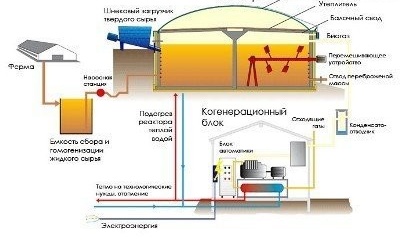
Industrial biogas plants are successfully used on farms. The productivity of biogas production is so great that its quantity is enough to heat greenhouses located near farms, private houses
Read more about this installation in our article - How to build a biogas plant: do-it-yourself bioreactor.
Septic tank for plum processing
Liquid waste is recycled using septic tanks. This technology is already sufficiently developed, and many domestic companies are engaged in the manufacture of integrated equipment for the treatment of domestic wastewater. The most famous is the product under the names "Tank», «Topas», «Triton», BCS, «Cedar».
Liquid drains from the house fall into a large tank, divided into several tanks. The suspension settles at the bottom, where it is exposed to anaerobic exposure. The purified liquid is discharged to the filtration field, and from there - for the needs of the infield. After the procedure, the water becomes 97-98% purified.
Thus, using modern technologies in the device of water supply, heating and sewage systems, it is possible to build an eco-house that is absolutely safe for the environment, however, it is quite comfortable and cozy.
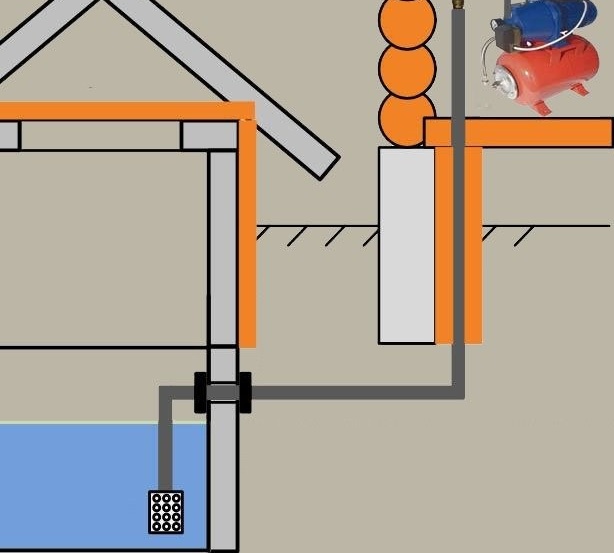
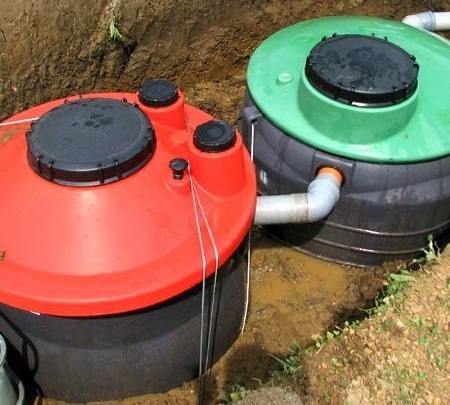
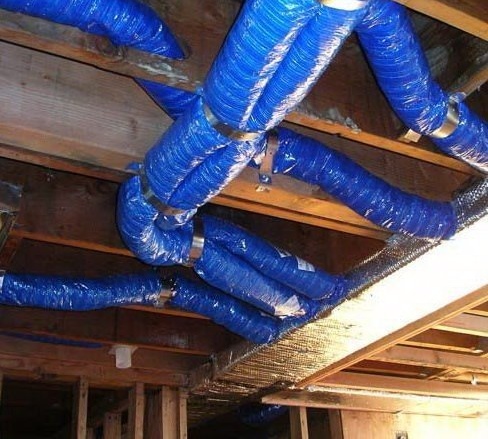
2 comments